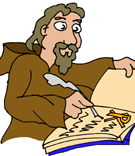|

|
|

All about them.

|
- After the Romans
left Britain, ordinary British people did not keep up
their reading and writing.
- Only priests, monks
and nuns
in the Church could write.
- The British spoke their
own language similar to Welsh. The Scots spoke Gaelic.
However, monks from both groups wrote in Latin.
Latin was the old Roman language.
- The British borrowed a
type of writing called Ogham from the Irish.
They only used this for name tags and gravestones.
- Saxons who settled
in Britain did not read or write books. They spoke a language
similar to English and had a simple alphabet of letters called
Runes. Runes were also only used
for name tags and gravestones.
- When the Saxons became
Christian, their monks and priests began to write books in
Latin too.
- Only after several
centuries did people begin to write the same language
that they spoke.
- There were no printing
presses or photocopiers. So all books had to be written by
hand. Something which is hand-written is sometimes called a
'manuscript'.
- These were often
decorated with pretty pictures: especially the first letter on
a page. The pictures were often painted in colourful inks and
covered in real gold! This is called 'illumination'.
- Books and manuscripts
were very valuable. They were only owned by Kings or Bishops
or by the monks & nuns in monasteries.
- Famous British books
include 'The Ruin &
Conquest of Britain' by St. Gildas, 'The History of
the Britons' by Nennius and the 'Welsh Annals'.
- Famous Saxon books
include the 'Ecclesiastical History of the English People' by
St. Bede and the 'Anglo-Saxon Chronicles'.
- The 'Lichfield
Gospel'
(or the 'Book of Teilo') is a famous British illuminated
manuscript.
- The 'Lindisfarne
Gospel'
is a famous Saxon illuminated manuscript.
- The 'Book of Kells' is a
famous Scottish illuminated manuscript.
- Activity
Sheets available.
|
|

